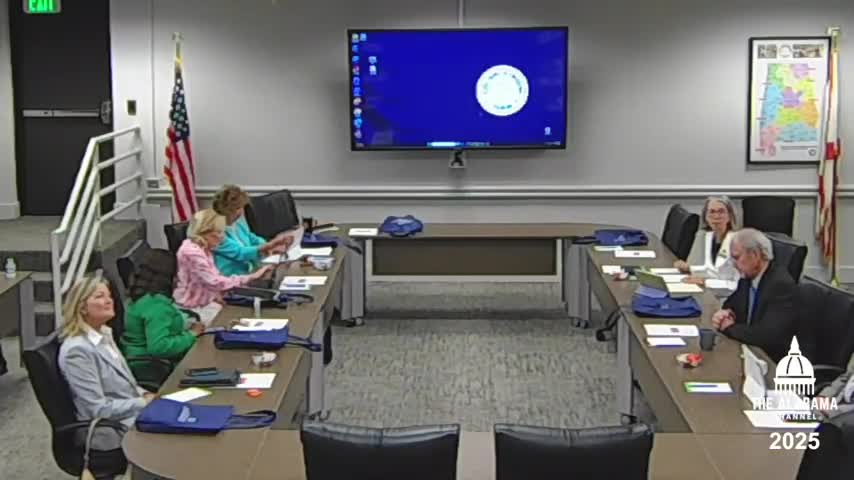State board hears University of South Alabama presentation on proposed educator-prep program
October 17, 2025 | Alabama State Department of Education, State Agencies, Executive, Alabama
This article was created by AI summarizing key points discussed. AI makes mistakes, so for full details and context, please refer to the video of the full meeting. Please report any errors so we can fix them. Report an error »

The Alabama State Board of Education heard a presentation on a proposed educator preparation program at the University of South Alabama, including the college’s recruitment, retention and curriculum changes intended to produce classroom-ready teacher candidates.
The program presentation, delivered by the University of South Alabama dean of the College of Education and Professional Studies, summarized enrollment and retention data, described a coordinated four-course numeracy sequence and highlighted improvements in first-time licensure test pass rates. The department listed the item on the meeting agenda as "to adopt the educator prep program at the University of South Alabama." The board did not record an adoption vote in the transcript excerpt provided.
The dean said the college is addressing a largely flat enrollment trend by expanding recruitment and earlier touchpoints for students. "We're in the process of redesigning programs so that we have those early experiences set out for students," she said, describing plans to give freshmen and sophomores earlier field experiences such as tutoring at local organizations and short classroom routines with small groups.
She outlined a four-course numeracy progression that moves from approximately 80% mathematics/20% pedagogy in the first course to 20% mathematics/80% pedagogy in the fourth course, with each course increasing the amount of classroom planning and data-informed instruction. The intent, she said, is to develop mathematical reasoning and classroom practice across the candidate’s program of study rather than waiting until junior or senior years for clinical experiences.
The college also reported growth in its UTeach pathway (students majoring in math and science who choose education). "We have doubled from one year to the next," the dean said about current UTeach enrollments and noted an initial cohort of five completers expected the following year.
On assessment outcomes, the dean cited improvement in teacher licensure first-time pass rates on the Foundations of Reading (appearing in the presentation as a college success metric): "From '23 through '25, we moved from 80 percent first-time pass rate to 90 percent first-time pass rate." She tied that improvement to an existing support program being pulled into coursework to increase early mastery.
Board members asked about causes of enrollment declines and whether broader university recruitment priorities affect teacher pipelines. A board member noted President Bonner’s emphasis on the medical school and other growth areas; the dean responded that recruitment is a national trend and that the university’s provost, with a background in elementary education, has been active in recruitment outreach.
The presentation concluded with the board taking questions; the transcript does not show a recorded formal vote on the item in the excerpt provided.
The program presentation, delivered by the University of South Alabama dean of the College of Education and Professional Studies, summarized enrollment and retention data, described a coordinated four-course numeracy sequence and highlighted improvements in first-time licensure test pass rates. The department listed the item on the meeting agenda as "to adopt the educator prep program at the University of South Alabama." The board did not record an adoption vote in the transcript excerpt provided.
The dean said the college is addressing a largely flat enrollment trend by expanding recruitment and earlier touchpoints for students. "We're in the process of redesigning programs so that we have those early experiences set out for students," she said, describing plans to give freshmen and sophomores earlier field experiences such as tutoring at local organizations and short classroom routines with small groups.
She outlined a four-course numeracy progression that moves from approximately 80% mathematics/20% pedagogy in the first course to 20% mathematics/80% pedagogy in the fourth course, with each course increasing the amount of classroom planning and data-informed instruction. The intent, she said, is to develop mathematical reasoning and classroom practice across the candidate’s program of study rather than waiting until junior or senior years for clinical experiences.
The college also reported growth in its UTeach pathway (students majoring in math and science who choose education). "We have doubled from one year to the next," the dean said about current UTeach enrollments and noted an initial cohort of five completers expected the following year.
On assessment outcomes, the dean cited improvement in teacher licensure first-time pass rates on the Foundations of Reading (appearing in the presentation as a college success metric): "From '23 through '25, we moved from 80 percent first-time pass rate to 90 percent first-time pass rate." She tied that improvement to an existing support program being pulled into coursework to increase early mastery.
Board members asked about causes of enrollment declines and whether broader university recruitment priorities affect teacher pipelines. A board member noted President Bonner’s emphasis on the medical school and other growth areas; the dean responded that recruitment is a national trend and that the university’s provost, with a background in elementary education, has been active in recruitment outreach.
The presentation concluded with the board taking questions; the transcript does not show a recorded formal vote on the item in the excerpt provided.
View full meeting
This article is based on a recent meeting—watch the full video and explore the complete transcript for deeper insights into the discussion.
View full meeting
